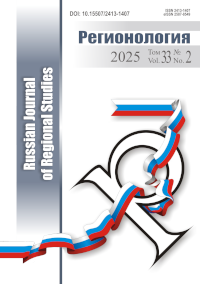A. G. Filipova, A. V. Vysockaya. Studying General Secondary Education Systems in the Regions of Russia: the ‘Gray Box’ Method
A. G. Filipova, A. V. Vysockaya. Studying General Secondary Education Systems in the Regions of Russia: the ‘Gray Box’ Method
Acknowledgements: the work was performed with the financial support of the Russian Foundation for Basic Research (project No. 16-36-60041).
Key words: region; general education; average Unified State Examination score; gray box; regional factors; regression analysis
Introduction: socio-economic inequality in the Russian regions has become the basis for unequal access of children and young people to educational resources. In the regional context, the average Unified State Examination score may serve as a means of fixing the regional differences of general education systems. The task of the fragment of research presented in the article is to describe the regional systems of children’s general education, to identify regional factors affecting the effectiveness of the systems and to assess the strength of this influence.
Materials and Methods: the use of the ‘gray box’ method for studying regional systems of general education allowed to determine the ‘Inputs’ and ‘Outputs’ of a system, to outline its internal structure and to proceed to the identification of links between elements (factors) of the system and the environment, to assess the strength of these influences. A set of 30 control factors affecting the effectiveness of the Unified State Examination was formed: ‘Demography’ (9 factors), ‘General education’ (14 factors), ‘Economy and infrastructure of the region’ (7 factors). The quantitative content of these 30 control factors, as well as the target factor (the average score of the Unified State Examination) was carried out by means of using statistical information. The selected three periods of observation are school years 2013—14, 2014—15 and 2015—16.
Results: in each period, a set of three control factors was obtained by means of regression analysis. In the school year 2013—14, it was х1 (the proportion of the population with incomes below the subsistence level), х16 (the proportion of night schools of general education) and х18 (the proportion of ill-equipped schools). In the school year 2014—15, it was х18 (the proportion of ill-equipped schools), х27 (the proportion of households with a personal computer with Internet access) and х29 (the employment rate). In the school year 2015—16 it was х1 (the proportion of the population with incomes below the subsistence level), х10 (the proportion of the average salary of teachers of general education institutions to the average salary in the region), х18 (the proportion of ill-equipped schools). In all the three periods, influence of factor х18 on у (the average point of the unified state examination) with approximately identical force was noted. In two of the three periods, у is influenced by х1 and, in the remaining period, the regression equation included х29 (the employment rate), which has a moderate relationship with х1.
Discussion and Conclusions: the ‘gray box’ method allowed to reveal some elements of the model, interrelations between elements of the model and the environment as well as to remove excess indicators, which will reduce the time needed for functional and non-functional modeling. The search for new control factors as well as the establishment of their mathematical relations with the already identified factors will be the objectives of the next stage of the research.
REFERENCES
1. Zubarevich N.V., Safronov S.G. [Inequality of Socio-Economic Development of Regions and Cities of Russia in the 2000s: Growth or Decline?]. Obshhestvennye nauki i sovremennost’ = Social Sciences and Contemporary World. 2013; 6:15—26. Available at: http://ecsocman.hse.ru/data/2015/05/25/1251201390/15-26_Zubarevich.pdf (accessed 14.08.2017). (In Russ.)
2. Prakhov I.A. [Barriers Limiting Access to Quality Higher Education in the Context of the USE: Family and School as Constraining Factors]. Voprosy obrazovaniya = Educational Studies. 2015; 1:88—117. Available at: https://memo.hse.ru/data/2015/11/11/1078548296/1-2015_Prakhov.pdf (accessed 14.08.2017). (In Russ.)
3. Filipova A.G., Vysockaya A.V. [Educational Potential of Childhood in Russian Regions]. Diskurs = Discours. 2017; 8:127—134. Available at: http://journal-discurs.ru/index.php/91-8-2107/410-filipova-a-g-vysotskay... (accessed 03.08.2017). (In Russ.)
4. Tsareva E.N., Ryzhkova M.N. [System for Learning Process Optimization]. Otkrytoe i distancionnoe obrazovanie = Open and Distance Education. 2014; 2:64—68. Available at: http://files.amisod.ru/mediacontent/vipuski/2014/4/amisod-2014-04-29-tsa... (accessed 14.08.2017). (In Russ.)
Contribution of the authors:
Alexandra G. Filipova — academic advising, critical analysis of the materials, final revision of the text of the article.
Alena V. Vysockaya — search for analytical materials, writing the initial version of the text of the article.
About the authors:
Alexandra G. Filipova, Doctor of Sociological Sciences, Associate Professor, Professor at the Department of Social and Psychological Sciences, Far Eastern Federal University (Bldg A (24), FEFU Campus, Russky Isl., Vladivostok 690922, Russia) (e-mail: alexgen77@list.ru). ORCID: http://orcid.org/0000-0002-7475-1961. Researcher’s ID: L-5384-2015.
Alena V. Vysockaya, Acting Head of the Department of Information Systems, Komsomolsk-on-Amur State Technical University (27 Lenin Ave., Komsomolsk-on-Amur, Khabarovsk Territory, 681013, Russia) (e-mail: al-w-buaa@rambler.ru). ORCID: https://orcid.org/0000-0001-7048-028X. Researcher’s ID: W-4879-2017.
For citation: Filipova A.G., Vysockaya A.V. Studying General Secondary Education Systems in the Regions of Russia: the ‘Gray Box’ Method. REGIONOLOGIYA = REGIONOLOGY. 2018; 1(26):155—178. DOI: 10.15507/2413-1407.102.026.201801.155-178

Материалы журнала "РЕГИОНОЛОГИЯ REGIONOLOGY" доступны по лицензии Creative Commons «Attribution» («Атрибуция») 4.0 Всемирная
















